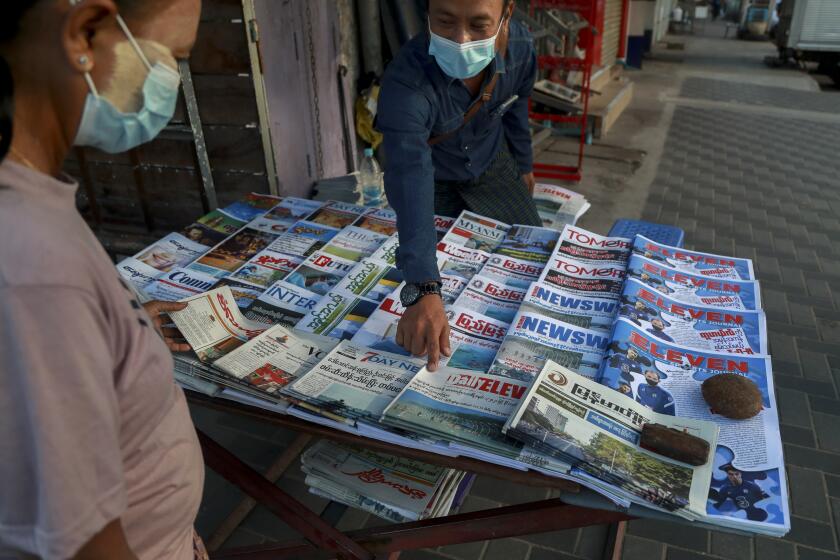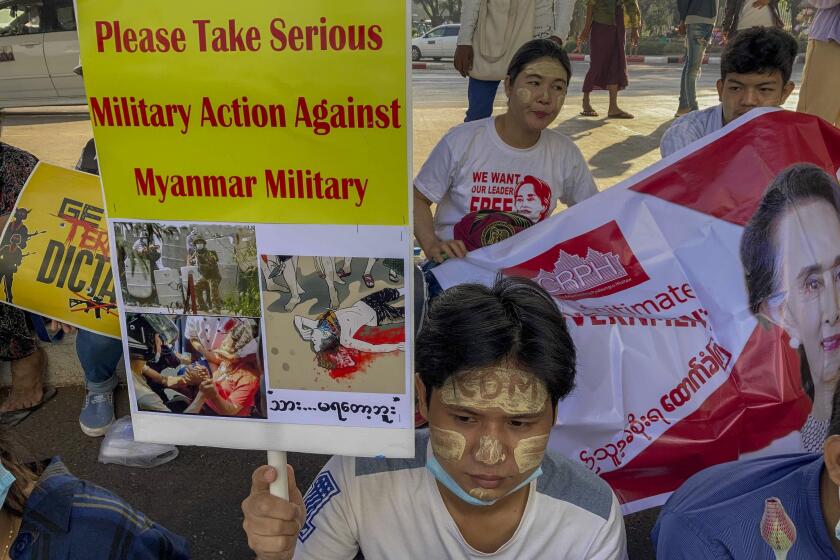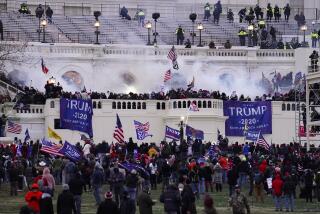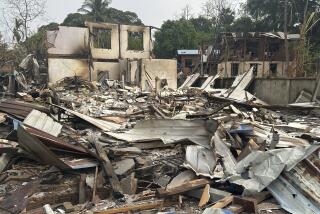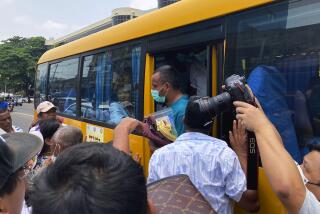Retreat, regroup, return, repeat: Protesters persevere in Myanmar despite crackdown
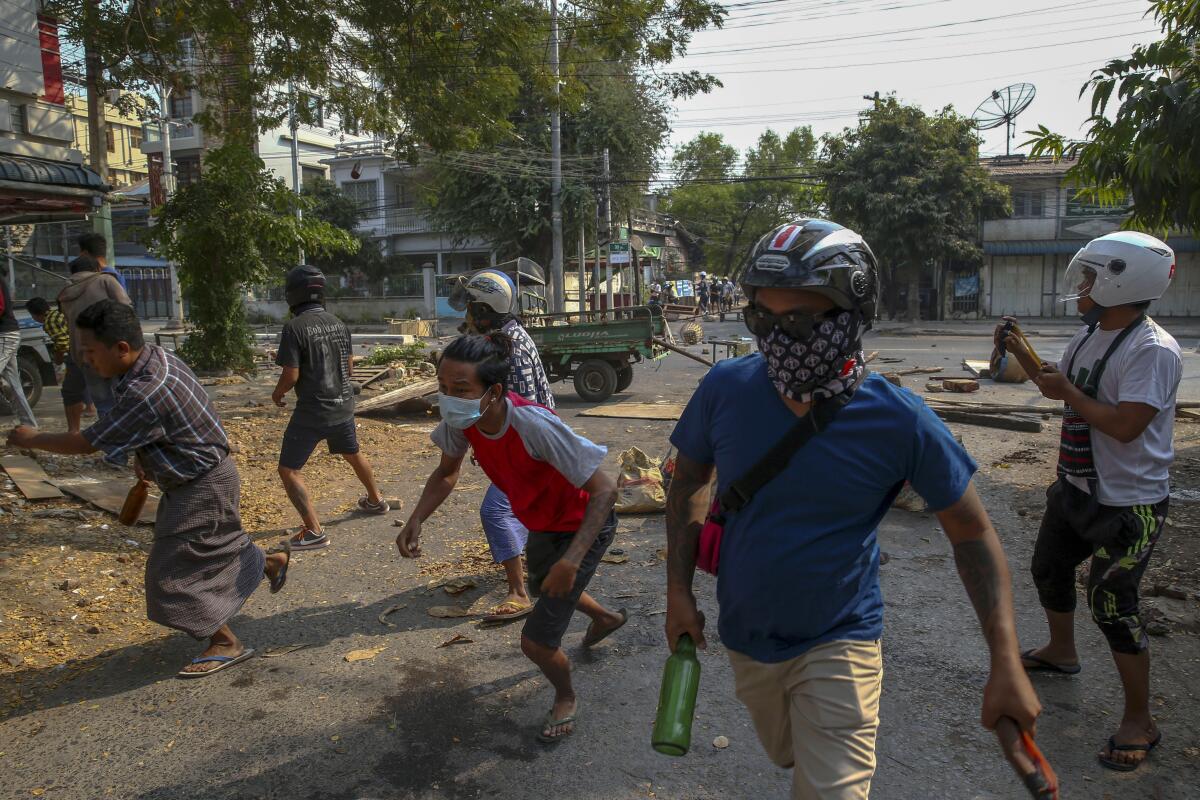
YANGON, Myanmar â Demonstrators in Myanmar took to the streets again Tuesday to protest last monthâs military coup as foreign ministers from Southeast Asian countries met to discuss the political crisis. Police in Yangon, Myanmarâs biggest city, used tear gas and rubber bullets against the protesters.
The special meeting of the Assn. of Southeast Asian Nations, held by video conference because of the pandemic, comes in the wake of worsening violence in Myanmar. The countryâs new military rulers have escalated their use of deadly force and mass arrests over the weekend to try to quash protests against the Feb. 1 coup that ousted the elected government led by Aung San Suu Kyi.
The United Nations said it believed that at least 18 people in several cities were killed Sunday when security forces opened fire to disperse demonstrators. Funerals were being held Tuesday for several of the victims.
The authorities also detained more than 1,000 people over the weekend, according to the independent Assistance Assn. for Political Prisoners.
Those detained over the weekend included at least seven journalists. At least two dozen journalists have been detained since the militaryâs takeover.
The crackdown has drawn international condemnation. U.N. Secretary-General Antonio Guterres called the use of lethal force against peaceful protesters and arbitrary arrests âunacceptable.â The U.S. has imposed sanctions on the coupâs leaders.
The viral video shows a military convoy storming the gates of parliament in the capital Naypyidaw.
However, there was no sign Tuesday that the junta was backing down. At the same time, it appeared that the protesters, who have employed nonviolent tactics, are beginning to resist more rigorously. In the past few days, more have been carrying homemade shields and wearing construction helmets, and videos show a greater number trying to stand their ground and throw objects at the police.
Some fear the juntaâs escalating use of force is meant to provoke a violent backlash by the demonstrators in order to discredit them and justify an even harsher crackdown.
U.N. Special Envoy on Myanmar Christine Schraner Burgener described the situation as âvery dangerousâ because she believes the army is waiting for the protesters to take up arms to defend themselves.
âI beg the people in Myanmar not to fall in this trap, so to stay peaceful,â she said Monday on CNN, though she acknowledged that it was easier for her, safely away from the violence, to urge peaceful protesting. She also accused the authorities of spreading rumors about the conditions of people already under detention to stir up even more anger on the streets.
When it comes to Myanmar, also known as Burma, a lot is contained in a name.
Hundreds of protesters gathered Tuesday morning in the Hledan area of Yangon, where a day earlier police had fired repeated rounds of tear-gas canisters. The protesters, many of whom wore construction helmets, dragged bamboo poles and debris to form barricades to impede any police attempt to rush forward and make arrests, and chanted slogans and sang songs at the police lines. They even threw banana skins onto the road in front of them as an extra hazard to any police rush.
The demonstrators â hundreds of mainly young people â fled in panic as tear gas was deployed but soon returned to their barricades. The retreat-and-regroup tactic was repeated over and over as police kept the pressure on.
Videos posted on social media showed similar chaotic scenes in the Insein neighborhood of northern Yangon.
Protesters also took up their flags and banners to march through the streets of Dawei, a small city in southeastern Myanmar that has seen almost daily large demonstrations against the coup.
Supporters of Myanmarâs ruling junta used slingshots, iron rods and knives to attack protesters demanding an end to the military government.
Some marchers also carried metal shields. Dawei had been the scene Sunday of a violent crackdown, with up to five people killed when security forces shot into a large crowd of demonstrators.
Two groups of demonstrators marched Tuesday morning. One group was targeted by the security forces as it entered a narrow street on its way to pay respects at the house of a man killed in Sundayâs crackdown. Another was attacked on the main street in the cityâs center.
Police also dispersed protests in Mandalay, Myanmarâs second-largest city.
The coup reversed years of slow progress toward democracy in Myanmar after five decades of military rule, coming on the day that a newly elected parliament was supposed to take office. Suu Kyiâs National League for Democracy party would have been installed for a second five-year term in office, but instead she was detained along with President Win Myint and other senior officials.
The military government has charged Suu Kyi with several criminal offenses that critics say are politically motivated and are meant to keep her locked up. If convicted of any of the charges, she would probably be barred from taking part in the election promised in a yearâs time by the military.
News Alerts
Get breaking news, investigations, analysis and more signature journalism from the Los Angeles Times in your inbox.
You may occasionally receive promotional content from the Los Angeles Times.
The U.N.âs independent expert on human rights in Myanmar, Tom Andrews, proposed Monday that countries could impose a global embargo on arms sales to Myanmar and âtough, targeted and coordinated sanctionsâ against those responsible for the coup, the crackdown and other rights abuses.
Any kind of coordinated action at the United Nations, however, would be difficult since two permanent members of the Security Council, China and Russia, would almost certainly veto it. ASEANâs policy of seeking a consensus among its members also makes it unlikely to take strong action at Tuesdayâs meeting.
More to Read
Sign up for Essential California
The most important California stories and recommendations in your inbox every morning.
You may occasionally receive promotional content from the Los Angeles Times.
